Input interpretation

chlorobenzene
Chemical names and formulas

formula | C_6H_5Cl name | chlorobenzene alternate names | benzene chloride | chlorbenzene | chlorobenzol | monochlorobenzene | phenyl chloride mass fractions | C (carbon) 64% | Cl (chlorine) 31.5% | H (hydrogen) 4.48%
Lewis structure
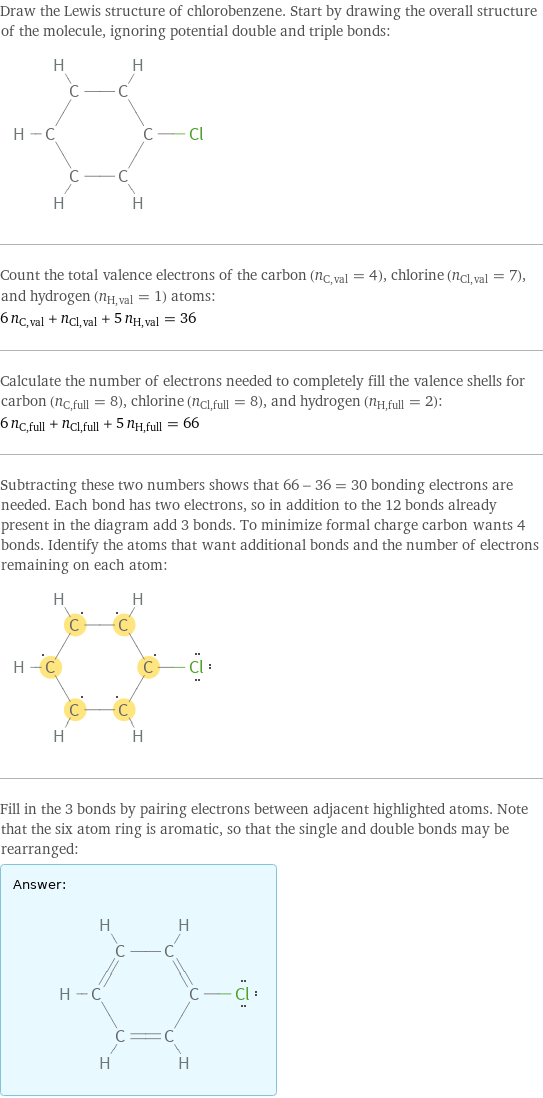
Draw the Lewis structure of chlorobenzene. Start by drawing the overall structure of the molecule, ignoring potential double and triple bonds: Count the total valence electrons of the carbon (n_C, val = 4), chlorine (n_Cl, val = 7), and hydrogen (n_H, val = 1) atoms: 6 n_C, val + n_Cl, val + 5 n_H, val = 36 Calculate the number of electrons needed to completely fill the valence shells for carbon (n_C, full = 8), chlorine (n_Cl, full = 8), and hydrogen (n_H, full = 2): 6 n_C, full + n_Cl, full + 5 n_H, full = 66 Subtracting these two numbers shows that 66 - 36 = 30 bonding electrons are needed. Each bond has two electrons, so in addition to the 12 bonds already present in the diagram add 3 bonds. To minimize formal charge carbon wants 4 bonds. Identify the atoms that want additional bonds and the number of electrons remaining on each atom: Fill in the 3 bonds by pairing electrons between adjacent highlighted atoms. Note that the six atom ring is aromatic, so that the single and double bonds may be rearranged: Answer: | |
3D structure

3D structure
Basic properties
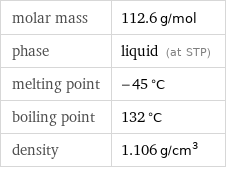
molar mass | 112.6 g/mol phase | liquid (at STP) melting point | -45 °C boiling point | 132 °C density | 1.106 g/cm^3
Units

Liquid properties (at STP)

density | 1.106 g/cm^3 vapor pressure | 11.8 mmHg dynamic viscosity | 7.53×10^-4 Pa s (at 25 °C) surface tension | 0.033 N/m sound speed | 4720 km/h (at 20 °C (degrees Celsius)) refractive index | 1.524
Units

Thermodynamic properties
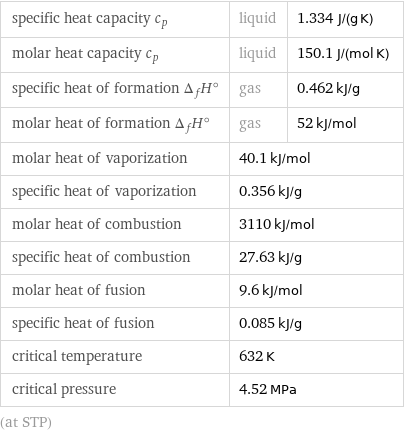
specific heat capacity c_p | liquid | 1.334 J/(g K) molar heat capacity c_p | liquid | 150.1 J/(mol K) specific heat of formation Δ_fH° | gas | 0.462 kJ/g molar heat of formation Δ_fH° | gas | 52 kJ/mol molar heat of vaporization | 40.1 kJ/mol | specific heat of vaporization | 0.356 kJ/g | molar heat of combustion | 3110 kJ/mol | specific heat of combustion | 27.63 kJ/g | molar heat of fusion | 9.6 kJ/mol | specific heat of fusion | 0.085 kJ/g | critical temperature | 632 K | critical pressure | 4.52 MPa | (at STP)
Chemical identifiers
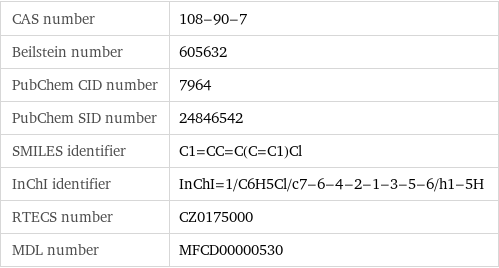
CAS number | 108-90-7 Beilstein number | 605632 PubChem CID number | 7964 PubChem SID number | 24846542 SMILES identifier | C1=CC=C(C=C1)Cl InChI identifier | InChI=1/C6H5Cl/c7-6-4-2-1-3-5-6/h1-5H RTECS number | CZ0175000 MDL number | MFCD00000530
NFPA label

NFPA label
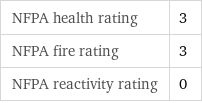
NFPA health rating | 3 NFPA fire rating | 3 NFPA reactivity rating | 0
Safety properties

flash point | 23.89 °C autoignition point | 590 °C lower explosive limit | 1.3% (concentration in air) upper explosive limit | 11% (concentration in air)

DOT hazard class | 3 DOT numbers | 1134